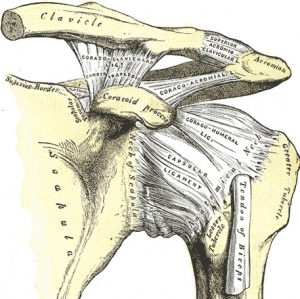Acromioclavicular Joint: Difference between revisions
Tyler Shultz (talk | contribs) No edit summary |
Tyler Shultz (talk | contribs) No edit summary |
||
| Line 3: | Line 3: | ||
== Description == | == Description == | ||
The Acromioclavicular Joint, or AC joint, is one of four joints that compose the [[Shoulder|shoulder]] complex. The AC joint is formed by the junction of the lateral clavicle and the acromion process of the scapula, and is a gliding, or plane style joint. The AC joint serves as the main articulation that suspends the upper extremity from the trunk, and it is at this joint about which the scapula moves<ref>[Dutton, M. (2008). Orthopaedic: Examination, evaluation, and intervention (2nd ed.). New York: The McGraw-Hill Companies, Inc.]</ref>. | The Acromioclavicular Joint, or AC joint, is one of four joints that compose the [[Shoulder|shoulder]] complex. The AC joint is formed by the junction of the lateral clavicle and the acromion process of the scapula, and is a gliding, or plane style synovial joint. The AC joint serves as the main articulation that suspends the upper extremity from the trunk, and it is at this joint about which the scapula moves<ref>[Dutton, M. (2008). Orthopaedic: Examination, evaluation, and intervention (2nd ed.). New York: The McGraw-Hill Companies, Inc.]</ref>. | ||
== Motions Available<ref needed><br> == | == Motions Available<ref needed><br> == | ||
Revision as of 03:19, 31 January 2009
Description[edit | edit source]
The Acromioclavicular Joint, or AC joint, is one of four joints that compose the shoulder complex. The AC joint is formed by the junction of the lateral clavicle and the acromion process of the scapula, and is a gliding, or plane style synovial joint. The AC joint serves as the main articulation that suspends the upper extremity from the trunk, and it is at this joint about which the scapula moves[1].
Motions Available<ref needed>
[edit | edit source]
- Rotation:
- Pure Spin: a pure spin occurs during abduction or adduction motions of the upper extremity.
- Glides: gliding of the AC joint can occur in either a anterior to posterior direction, or a superior to inferior direction.
Ligaments and Joint Capsule
[edit | edit source]
The AC joint capusle and ligaments surrounding the joint work together to provide stability and to keep the clavicle in contact with the acromion process of the scapula.
Joint Capsule: The AC joint has a thin capsule lined with synovium, which is strengthened by capsular ligaments both inferiorly and superiorly.
Ligaments:
- Coracoclavicular Ligaments: Composed of the conoid and trapezoid ligaments, this ligament is the primary support ligament of the AC joint. The coracoclavicular ligaments run from the coracoid process to the underside of the clavicle, near the AC joint.
- The Conoid Ligament is the fan shaped component of the coracoclavicular ligament. It is located more medailly than the trapezoid ligament. This ligament functions to prevent the inferior movement of the coracoid away from the clavicle.
- The Trapezoid Ligament
- The AC Ligament serves to reinforce the joint capsule and serves as the primary restraint to posterior translation and posterior axial rotation at the AC joint.[2]
Muscles[edit | edit source]
Closed Packed Position[edit | edit source]
The closed packed position of the AC joint occurs when the GH joint is abducted to 90 degrees.
Open Packed Position[edit | edit source]
The open packed position of the AC joint is undetermined.
Other Important Information[edit | edit source]
Resources[edit | edit source]
- Dutton, M. (2008). Orthopaedic: Examination, evaluation, and intervention (2nd ed.). New York: The McGraw-Hill Companies, Inc.
- Levangie, P.K. & Norton, C.C. (2005). Joint structure and function: A comprehensive analysis (4th ed.). Philadelphia: The F.A. Davis Company.
References
[edit | edit source]







